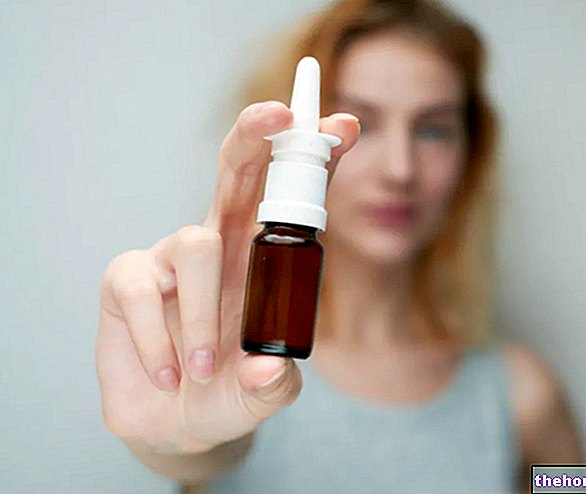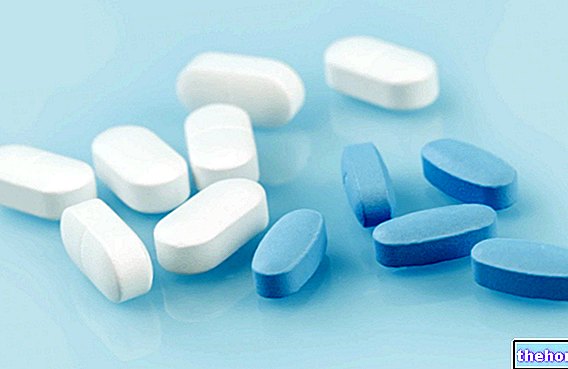Definition
Hepatitis outlines an "inflammation of the liver, the severity of which depends on the causal element responsible for the inflammatory process (virus, drug abuse, alcohol, ingestion of Amanita phalloides, autoimmune diseases). Cirrhosis represents the most fearful complication of hepatitis.
Classification, causes and symptoms
There are several forms of hepatitis:
- Hepatitis A. Cause: RNA virus (HAV). Transmission: by the fecal-oral route (food and contaminated water). Main symptoms: anorexia, abdominal pain, fever, jaundice, general malaise, nausea, vomiting.
- Hepatitis B. Cause: HBV virus. Transmission: unprotected sexual intercourse, occupational exposure, mixed use of infected syringes. Symptoms: impaired liver function, anorexia, fever, severe abdominal pain, jaundice, nausea, vomiting.
- Hepatitis C. Cause: virus Hepatitis C Virus (HCV). Transmission: contact with infected blood (e.g. maternal-fetal route, transfusion of infected blood, infected syringes, etc.). Symptoms: liver changes, weakness, abdominal pain, glomerulo-nephritis, loss of appetite, nausea.
Hepatitis D, E, G are other forms of virus-associated inflammation of the liver.
The other types of hepatitis may depend on an "excessive intake of drugs (NSAIDs, antibiotics, paracetamol, some steroids), alcohol, drugs (eg. Ephedra, cascara) or toxic substances (aggressive solvents, herbicides, industrial chemicals, etc." ): in this case, we speak more correctly of toxic hepatitis Autoimmune subjects represent the category most at risk of hepatitis.
Diet and Nutrition
The information on Hepatitis - Medicines for the Treatment of Hepatitis is not intended to replace the direct relationship between health professional and patient. Always consult your doctor and / or specialist before taking Hepatitis - Medicines to Treat Hepatitis.
Medicines
Different and varied are the drugs used in therapy for the treatment of hepatitis; the treatment depends on the underlying cause of the problem.
Clearly, the patient suffering from toxic hepatitis must first be treated by eliminating the responsible agent: for example, when the disease depends on an abuse of paracetamol, the first measure to be followed is represented by the interruption of the drug.
Viral hepatitis prophylaxis is very important: to prevent viral inflammation of the liver, vaccination and passive immunization through the administration of gammaglobulins are recommended, as well as observing simple rules of hygiene and behavior.
Now let's see in more detail some drugs used in therapy for the various forms of hepatitis.
The following are the classes of drugs most used in the therapy against hepatitis and some examples of pharmacological specialties; it is up to the doctor to choose the most suitable active ingredient and dosage for the patient, based on the severity of the disease, the state of health of the patient and his response to treatment:
Toxic hepatitis
For the treatment of drug-induced hepatitis there is no specific treatment, if not the immediate suspension of the drug responsible for the damage.
In case of acute iatrogenic hepatitis, it is recommended to rest and possibly the administration of fluids intravenously in case of nausea, vomiting and severe diarrhea, in order to avoid dehydration of the body. In some cases, it is possible to administer drugs antiemetics and antidiarrheals.
In case of paracetamol overdose, the patient is treated with the administration of:
- ACETYLCYSTEINE (eg Tirocular, Fluimucil, Mucofrin): remember that the drug carries out its therapeutic action only when taken within 16-24 hours from the overdose of paracetamol. Orally, take 140m g / kg (loading dose: minimum 4g, max. 15 g), in a single dose. Subsequently, continue the therapy by taking 70 mg / kg orally (4 hours after the loading dose), repeating the intake for 17 doses, every 4 hours. In case of vomiting within one hour of administration, repeat the previously taken dose. .
Alternatively, take 150 mg / kg in 200 ml of 5% dextrose intravenously over 60 minutes (not to exceed 15 grams). Take a second dose 4 hours after the first: 50 mg / kg in 500 ml of 5% dextrose for i.v. (maximum dose: 15 grams). Finally, inject into a vein 100 mg / kg of drug diluted in 1000 ml of 5% dextrose, after 16 hours (max dose 10 grams)
If liver function is severely compromised, the only solution is a liver transplant.
Hepatitis A
For further information: Drugs for the Treatment of Hepatitis A
Hepatitis A is an inflammation of the liver that generally tends to resolve itself in a month or two, leaving no permanent or serious damage; Affected patients often feel tired, fatigued, deprived of appetite, as well as feeling nauseous. In such situations it is recommended to rest, drink plenty of fluids, take light foods several times during the day and above all avoid the intake of alcohol and drugs such as NSAIDs; it is also recommended to stop smoking.
Important is the administration of standard gamma globulin antibodies within one to two weeks of infection. In the rare event of serious complications, liver transplantation may be required, an indispensable extreme life-saving remedy.
- Hepatitis A: vaccination. Passive immunization by administering standard gammaglobulins is a useful prophylaxis treatment to ensure short-term immunity; the hepatitis A vaccine guarantees a 10-20 year "immunization from" hepatitis A. Posology: the vaccine is injected intramuscularly in the deltoid area. A booster dose can be given 1 year after the initial dose. It is recommended to take another dose after 20 years if there is a risk of exposure to the hepatitis A virus.
Hepatitis B
For further information: Drugs for the Treatment of Hepatitis B
In general, the acute form of hepatitis B tends to self-resolve, therefore the patient, who is not treated with specific drugs, should respect some simple rules of behavior, such as rest, intake of lots of fluids (especially in case of vomiting and diarrhea ) and light foods, avoiding alcohol and hyperlipidic foods.
Some patients with hepatitis B are also treated with an "intravenous injection of specific immunoglobulins. For chronic forms of hepatitis B, healing times tend to be more extended: the doctor may prescribe the administration of antiviral drugs to protect liver function. and to eliminate the virus responsible for the damage.
- Peginterferon (ES. Pegasys, Pegintron) take 100 mcg of drug per week for 31 weeks; subsequently, continue the therapy by taking 50 mcg / week subcutaneously for 35-52 weeks. It is also possible to take the drug in combination with Lamivudine (eg Lamivudine / Zidovudine teva Lamivudine Teva), for subjects with HIV and hepatitis B: in this case, it is recommended to administer 100 mcg of peginterferon subcutaneously for 31 weeks and to continue treatment with 50 mcg per week for 32-52 weeks.
- Tenofovir (eg Viread) take 300 mg of the drug once a day. Indicated for chronic hepatitis B, the ideal duration of treatment is unknown. Consult your doctor.
- Lamivudine (eg Zeffix, Combivir, Epivir): the antiviral drug is indicated for the treatment of chronic hepatitis B. It is recommended to take the drug orally once a day at a dosage of 100 mg.
Patients in therapy for the treatment of hepatitis B should avoid the consumption of alcohol, ibuprofen, paracetamol, aspirin and salicylates in general, in order to avoid overloading the liver.
Again, liver transplantation may be the only emergency treatment if no drug is successful.
- Hepatitis B: vaccination. The Hbvaxpro vaccine consists of components of the hepatitis B virus and is given in three divided doses.
- Hepatitis B: passive immunoprophylaxis (eg Igantibe 1000 IU / 5ml, Niuliva 10000 IU / 40ml). Take 500 units by intramuscular injection for adults, 200 units for children under 4, 300 units for children aged 5 to 9, and 200 units for infants, immediately after birth.
Hepatitis C
For further information: Drugs for the Treatment of Hepatitis C
In some cases, hepatitis C, just like the forms described above, tends to regress spontaneously: in such situations, the patient must still adopt some simple behavioral measures, useful for speeding up the recovery from the disease (rest, avoid alcohol, take plenty of fluids , divide meals into numerous small snacks, avoid high-calorie and lipid-rich foods, do not take NSAIDs or antibiotics, if not essential. Consult your doctor).
In any case, the current therapy against hepatitis C consists in the administration of pegylated interferon alfa associated with ribavirin; let's see in more detail the method of administration, remembering however that the posology must always be perfected by the doctor, based on the severity of the symptoms and to the patient's response to treatment:
- Peginterferon alfa 2a (eg Pegasys) when used alone, take the drug at a dose of 180 mcg subcutaneously, every 7 days, for 48 weeks. When taken in combination with ribavirin, the dosage should be determined by the physician based on the patient's body weight. To hire:
- 180 mcg of drug subcutaneously once a week + 1g / day of oral ribavirin divided into two doses, for 48 weeks. For patients who weigh less than 75 pounds.
- 180 mcg of drug subcutaneously once weekly + 1.2g / day of oral ribavirin, divided into two doses, for 48 weeks. For people who weigh more than 75 kilos.
- 180 mcg of subcutaneous drug once weekly + 800 mg / day of oral ribavirin, divided into two doses, for 48 weeks. For patients with hepatitis C and HIV.
- Peginterferon alfa 2b (e.g. Pegintron, Viraferonpeg) take 1 mcg per kilo per week subcutaneously for 1 year. The posology, also in this case, must be perfected by the doctor based on the patient's weight. The minimum dose to take the drug on its own is 40 mcg once a week (<45 kg), the maximum dose is 150 mcg subcutaneously once a week (weight between 137 and 160 kilos). A similar argument is valid for combined therapy with ribavirin: once again, the dosage depends on the weight of the patient. For example, take 1.5 mcg of Peginterferon alfa 2b per kilo per week + 400 mg of ribavirin orally, divided into two doses for patients weighing less than 39 kg. The Peginterferon alfa 2b dose may increase up to 150 mcg per week, and that of ribavirin up to 1400 mg in two divided doses during the day (weight> 105 kg).
- Ribavirin (eg Rebetol) this drug is used in therapy with peginterferon alfa or interferon alfa 2b in patients over 18 years of age (not recommended for children and people under the age of 18). guarantees its effectiveness when used alone. For patients who weigh more than 65 kg, take 400 mg of the drug orally twice a day; if a patient weighs 65-85 kg, it is recommended to take 400 mg of the drug at the morning and 600 mg in the evening Above 85 kilos, it is recommended to take two doses of 600 mg per day Consult your doctor.
- Sofosbuvir (eg Sovaldi): recently introduced antiviral drug (November 2013) used in the treatment of chronic hepatitis C. From the clinical studies conducted so far, the drug has allowed the elimination of the virus up to over 90% of cases in the genotypes more susceptible. The only drawback is the still very high cost of the treatment which creates sustainability problems for public health. Sofosbuvir is taken orally; the recommended dose is one 400mg tablet once a day, to be taken with food. Sofosbuvir should be used in combination with other medicines to treat chronic hepatitis C, including ribavirin or peginterferon alfa and ribavirin.
- For hepatitis C prophylaxis, vaccination against hepatitis A and B is very useful: this reduces the risk of serious damage to the liver.




























